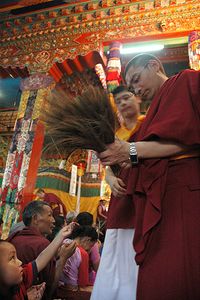Kusha grass: Difference between revisions
Jump to navigation
Jump to search
No edit summary |
mNo edit summary |
||
| Line 1: | Line 1: | ||
[[Image:Kusha grass.jpg|200px|thumb|Kusha grass]] | [[Image:Kusha grass.jpg|200px|thumb|Kusha grass]] | ||
'''Kusha grass''', also called ''darbha'' (Skt. ''kuśa''; ''Poa cynosuroides'' or ''Desmostachya bipinnata''; Tib. [[ཀུ་ཤ་]]) — a variety of grass considered sacred in India. The [[Buddha]] used this grass to make the meditation seat on which he attained [[enlightenment]] under the [[bodhi tree]]. For this reason it has a particular symbolic significance in Buddhist practice and is used in various rituals. | '''Kusha grass''', also called ''darbha'' (Skt. ''kuśa''; ''Poa cynosuroides'' or ''Desmostachya bipinnata''; Tib. [[ཀུ་ཤ་]], [[Wyl.]] ''ku sha'') — a variety of grass considered sacred in India. The [[Buddha]] used this grass to make the meditation seat on which he attained [[enlightenment]] under the [[bodhi tree]]. For this reason it has a particular symbolic significance in Buddhist practice and is used in various rituals. | ||
It is also sacred for Hindus. The plant is mentioned in the ''Rig Veda'' for use in sacred ceremonies and also as a seat for priests and gods. | It is also sacred for Hindus. The plant is mentioned in the ''Rig Veda'' for use in sacred ceremonies and also as a seat for priests and gods. | ||
Latest revision as of 01:50, 21 August 2017

Kusha grass, also called darbha (Skt. kuśa; Poa cynosuroides or Desmostachya bipinnata; Tib. ཀུ་ཤ་, Wyl. ku sha) — a variety of grass considered sacred in India. The Buddha used this grass to make the meditation seat on which he attained enlightenment under the bodhi tree. For this reason it has a particular symbolic significance in Buddhist practice and is used in various rituals.
It is also sacred for Hindus. The plant is mentioned in the Rig Veda for use in sacred ceremonies and also as a seat for priests and gods.